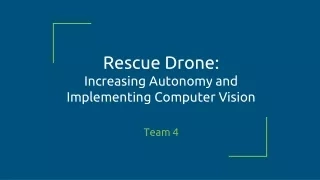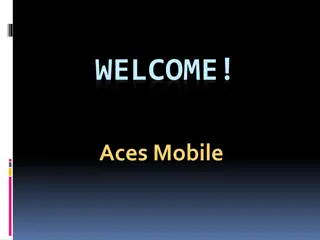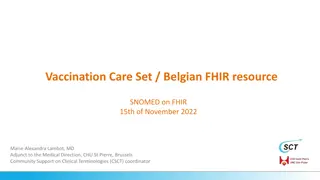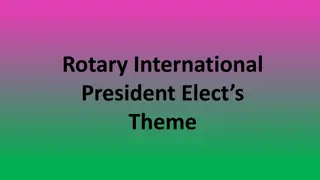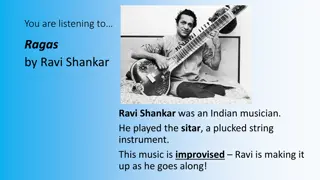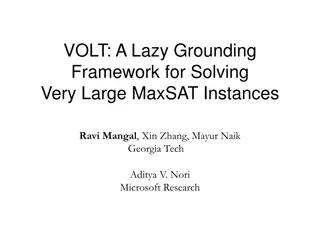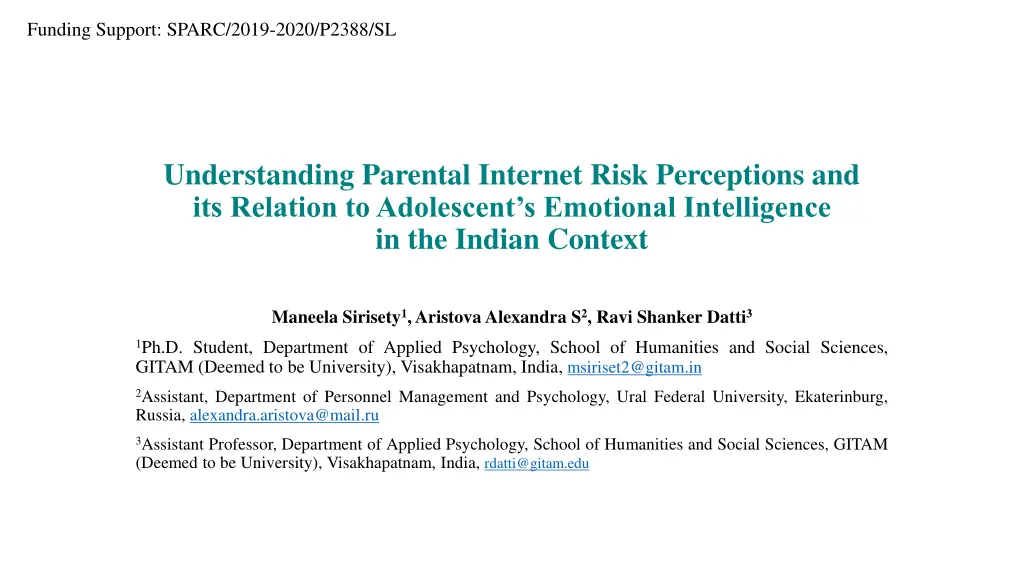
Understanding Parental Internet Risks and Adolescent Emotional Intelligence in India
This research project explores parental perceptions of internet risks among adolescents in India and their impact on emotional intelligence. The study aims to develop assessment procedures for online risks, create educational programs, and promote safe behavior online. With a focus on understanding the dynamics between parental perceptions and adolescent emotional intelligence, the project involves survey-based research in Visakhapatnam, Andhra Pradesh. The study sample consists of adolescents aged 13-19 and their parents, investigating topics such as internet usage, risk perception, and emotional intelligence competencies.
Download Presentation

Please find below an Image/Link to download the presentation.
The content on the website is provided AS IS for your information and personal use only. It may not be sold, licensed, or shared on other websites without obtaining consent from the author. If you encounter any issues during the download, it is possible that the publisher has removed the file from their server.
You are allowed to download the files provided on this website for personal or commercial use, subject to the condition that they are used lawfully. All files are the property of their respective owners.
The content on the website is provided AS IS for your information and personal use only. It may not be sold, licensed, or shared on other websites without obtaining consent from the author.
E N D
Presentation Transcript
Funding Support: SPARC/2019-2020/P2388/SL Understanding Parental Internet Risk Perceptions and its Relation to Adolescent s Emotional Intelligence in the Indian Context Maneela Sirisety1, AristovaAlexandra S2, Ravi Shanker Datti3 1Ph.D. Student, Department of Applied Psychology, School of Humanities and Social Sciences, GITAM (Deemed to be University), Visakhapatnam, India, msiriset2@gitam.in 2Assistant, Department of Personnel Management and Psychology, Ural Federal University, Ekaterinburg, Russia, alexandra.aristova@mail.ru 3Assistant Professor, Department of Applied Psychology, School of Humanities and Social Sciences, GITAM (Deemed to be University), Visakhapatnam, India, rdatti@gitam.edu
SPARC Funded Project on . Safe Behaviour on the Internet: Research, Training of Teachers, Parents and Adolescents India Russia . PI: Prof. Nalini Bikkina Co-PI: Dr. Ravi Shanker Datti PI: Dr. Eduard Patrakov Co-PI: Prof. Lyudmila Baturina OBJECTIVES: Develop an assessment procedure of online risks for adolescents. Create digital educational programs for teachers and parents. Create an application on the smartphones of parents and adolescents.
INTRODUCTION Usage of internet among adolescents is increasing at a rapid rate in India (IAMAI, 2022). The rapid usage has raised concerns about potential risks associated with online risks (Joseph et al., 2022; Tom et al., 2023) Parents play a crucial role in shaping adolescents' perceptions and behaviors regarding internet use (Patrakov, 2019) Given the continuous technology advancements, researchers must continuously assess the potential effects of technology on individuals mental health. OBJECTIVES 1. Understand the parental perceptions of adolescents internet risks among Indian households. 2. Examine the relationship between parental perceptions of internet risks and adolescents' emotional intelligence.
METHODOLOGY Research Design and Method: Quantitative, Cross-sectional, Survey research method Sample Characteristics: Age: Adolescents and parents of adolescents aged 13-19 years Location: Visakhapatnam, Andhra Pradesh Sampling Method: Convenience Sampling Sample Size: 158 parents and adolescents Measurements: Adolescents and Internet Scale (Patrakov, 2019) 22-item; 6-point rating scale Questions to parents regarding their children, general and internet-related behaviour. It measures parents perception of frequency of behaviour, anxiety produced due to behaviour, and overcoming the behaviour. Emotional Intelligence (Hall, Golden, 1998) 30-item, 5-point Likert scale (1 Strongly Disagree to 5 Strongly Agree) 5 EI competencies (self-awareness, self-regulation, self-motivation, empathy, and effective relationships)
Sociodemographic Characteristics of Participants Characteristic n % Characteristic n % Gender (Adolescents) Gender (Parent) Male 75 47.5 Male 86 54.4 Female 83 52.5 Female 72 45.6 Siblings Count Religion No Siblings 30 19.0 Hindu 101 63.9 One Sibling 110 69.6 Muslim 29 18.4 Two Siblings 18 11.4 Christianity 28 17.7 Socioeconomic Status Both the parents are present? Save even on food 6 3.8 Yes 149 94.3 Spend all money on food 17 10.8 No 9 5.7 Child has brain related trauma? Cover basic needs 82 51.9 Cover extra needs 26 16.5 Yes 6 3.8 Have enough wealth 27 17.1 No 152 96.2 Note: Sample Size = 158; Child Mean Age 16.8 (SD: 2.04); Parents Mean Age 43.9 (SD: 4.36)
Differences in Gender (Adolescents) on EI and Internet Scores Male (n=75) Female (n=83) Dimension t p M SD M SD Self-Awareness 20.39 4.77 22.21 3.94 -2.638 0.009 Empathy 20.31 5.11 21.88 4.26 -2.113 0.036 Internet Frequency 70.28 19.3 63.62 20.01 2.121 0.035
Differences in Religion on Internet Scores Dimension Religion Mean SD F Hindu (n=101) 63.50 21.26 Frequency Muslim (n=29) 65.62 1306 8.148** Christian (n=28) 79.86 15.26 Hindu (n=101) 61.76 22.92 Anxiety Muslim (n=29) 66.00 13.73 3.246* Christian (n=28) 72.74 14.12 Hindu (n=101) 59.30 21.20 Overcoming Muslim (n=29) 66.97 13.58 5.519** Christian (n=28) 71.21 9.03 Note: **p<0.01; * p<0.05
Differences in Number of Siblings Internet Scores Dimension Siblings count Mean SD F None (n=30) 58.87 18.53 Frequency One (n=109) 69.79 19.11 4.421** Two (n=18) 61.11 19.90 None (n=30) 53.76 23.60 Anxiety One (n=109) 66.93 19.24 3.111* Two (n=18) 62.17 20.24 None (n=30) 55.70 20.82 Overcoming One (n=109) 65.20 18.08 3.462* Two (n=18) 59.50 17.90 Note: **p<0.01; * p<0.05
Most often noticed behaviour of adolescents by parents Behaviour (n) Behaviour (n) Spends >2hrs a day using computer (games and social media) (n=64) Asks for money without explaining the purpose (n=58) Spends time on the internet which is detriment to studies and homework (n=57) Expresses apathy and indifference (n=58) Is aggressive and irascible (n=67) Has difficulty in sleeping (n=67) Has frequent headache (n=51) Presents themselves in a wrong way (n=59) Considers people met on social networking sites as close friends (n=55) Note: N=158; n=number of parents responded
Adolescents behaviour that produces anxiety among parents Behaviour (n) Behaviour (n) Spends >2hrs a day using computer (games and social media) (n=50) Asks for money without explaining the purpose (n=58) Spends time on the internet which is detriment to studies and homework (n=58) Demonstrates the regress of interest in studies (n=57) Wakes up with difficulty (n=51) Expresses apathy and indifference (n=60) Hides games he/she plays (n=52) Has difficulty in sleeping (n=70) Is aggressive and irascible (n=58) Presents themselves in a wrong way (n=54) Considers people met on social networking sites as close friends (n=56) Note: N=158; n=number of parents responded
Adolescents behaviour that parents has difficulty in handling Behaviour (n) Behaviour (n) Has difficulty in sleeping (n=70) Emotionally Unstable (n=59) Has frequent headache (n=66) Expresses apathy and indifference (n=54) Wakes up with difficulty (n=59) Presents themselves in a wrong way (n=58) Note: N=158; n=number of parents responded
RESULTS AND DISCUSSION Adolescents who are females are shown to have high scores of self-awareness and empathy compared to males. Similar results were observed in the literature in a different context (Hamaideh et al., 2024). Adolescents who are males are shown to have high scores on parents noticing internet related negative behaviour (overall) compared to females. Similar observations were seen in the literature (Wartberg et al., 2014) Parents belonging to Christian religion were shown to have high scores on noticing adolescents internet related negative behaviour, being anxious about the behaviour noticed, and having difficulty in managing the behaviour (overall) followed by Muslims. Hindus are shown to have low scores. Literature focuses highly on religious practices and religiosity on internet (Dosi et al., 2022; D ez Bosch and Mic , 2023). There is dearth of research studying adolescents internet behaviour from parents perpective by considering various religions adding to many limitations highlighted by Dawson and Cowan (2004). Adolescents who have one sibling were shown to have high scores on parents noticing adolescents internet related negative behaviour, being anxious about the behaviour noticed, and having difficulty in managing the behaviour (overall) followed by adolescents having two siblings. Adolescents with no siblings have low scores. The study findings can be attributed to observations made by Yu and Colleagues (2017) on only-child and adolescents with siblings.
CONCLUSION Limitations: Employing convenience sampling method and cross-sectional research design Social desirability bias Future Research: Comparing the results obtained using the same questionnaire among Russian parents and adolescents with Indian parents and children Developing education program to the parents and educators based on the results obtained Designing an application for parents and adolescents to monitor adolescents behaviour (without violating privacy) Implications: Identify and reduce risky behaviour on the internet Promote healthy online spaces Increasing the competence of parents, educators, and other stakeholders
References 1. Internet https://www.iamai.in/sites/default/files/research/Internet%20in%20India%202022_Print%20version.pdf and Mobile Association of India (IAMAI). 2022. Internet in India. 2. Joseph, J., Varghese, A., Vijay, V. R., Dhandapani, M., Grover, S., Sharma, S. K., Singh, M., Mann, S., & Varkey, B. P. (2022). Problematic Internet Use Among School-Going Adolescents in India: A Systematic Review and Meta-Analysis. Indian journal of community medicine : official publication of Indian Association of Preventive & Social Medicine, 47(3), 321 327. https://doi.org/10.4103/ijcm.ijcm_1129_21 3. Tom, A., Thomas, B., Sharma, M., & Joseph, A. (2023). Parental rejection and control: Potential risks for excessive Internet usage among adolescents. International Journal of Social Psychiatry, 69(8), 2007-2017. 4. Patrakov, E. V. (2019) Podrostki i internet: reaktsiya roditelej [Adolescents and the Internet: Reactions of parents]. Sibirskij psikhologicheskij zhurnal Siberian Journal of Psychology, no. 72, pp. 129 144. https://doi.org/10.17223/17267080/72/7 (In Russian) 5. Schutte, N. S., Malouff, J. M., Hall, L. E., Haggerty, D. J., Cooper, J. T., Golden, C. J., & Dornheim, L. (1998). Development and validation of a measure of emotional intelligence. Personality and Individual Differences, 25(2), 167 177. https://doi.org/10.1016/S0191-8869(98)00001-4 6. Dossi, F., Buja, A., & Montecchio, L. (2022). Association between religiosity or spirituality and internet addiction: A systematic review. Frontiers in public health, 10, 980334. https://doi.org/10.3389/fpubh.2022.980334 7. D ez Bosch and, M., & Mic , J. L. (2023). Internet, Mobile Technology, and Religion. The Handbook on Religion and Communication, 503-520. 8. Dawson, L. L., & Cowan, D. E. (Eds.). (2004). Religion online: Finding faith on the Internet. Psychology Press. 9. Yu, Q., Zhang, L., Wu, S., Guo, Y., Jin, S., & Sun, Y. (2017). The influence of juvenile preference for online social interaction on problematic Internet use: The moderating effect of sibling condition and the moderated moderating effect of age cohort. Computers in Human Behavior, 68, 345-351. 10. Wartberg, L., Kammerl, R., Br ning, S., Hauenschild, M., Petersen, K. U., & Thomasius, R. (2015). Gender-related consequences of Internet use perceived by parents in a representative quota sample of adolescents. Behaviour & Information Technology, 34(4), 341-348. 11. Hamaideh, S. H., Abuhammad, S., Khait, A. A., Al-Modallal, H., Hamdan-Mansour, A. M., Masa deh, R., & Alrjoub, S. (2024). Levels and predictors of empathy, self-awareness, and perceived stress among nursing students: a cross sectional study. BMC nursing, 23(1), 131.
ACKNOWLEDGEMENTS Funding: This study is funded by Scheme for Promotion of Academic and Research Collaboration (SPARC), IIT Kharagpur, India as a part of Joint India-Russia research project on Safe behavior on the Internet: research, training of teachers, parents and adolescents (SPARC/2019-2020/P2388/SL) Special Mention: I am grateful to Dr Eduard Patrakov (PI, Russia), Prof. Lyudmila Baturina (Co-PI, Russia), Prof. Nalini Bikkina (PI, India), Dr Ravi Shanker Datti (Co-PI, India) and the first year master's students of the Department of Applied Psychology, GITAM School of Humanities and Social Sciences for their continuous support during this process. I also thank the parents and children participated in this study.

